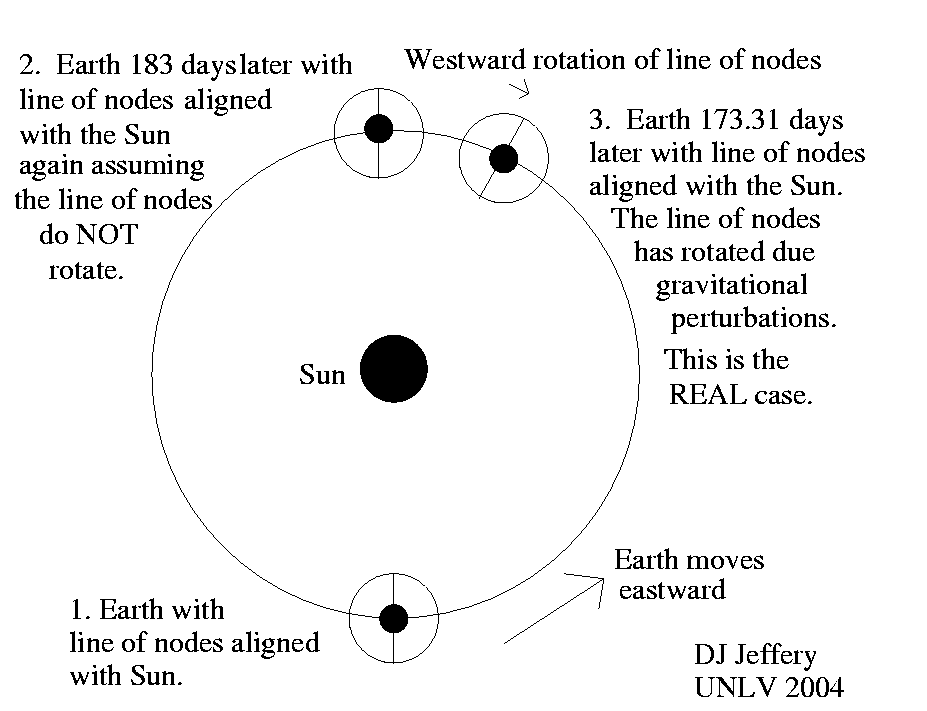
Caption: A diagram illustrating nodal alginments which determine the eclipse seasons: i.e., the periods when eclipses of any kind can occur.
Features:
- Eclipse seasons occur when
the lunar node line aligns with
the
Earth-Sun line.
(See also
Wikipedia: Orbital node.)
- Because the Earth,
Moon,
and Sun have finite sizes,
exact alignment of the lunar node line
(i.e., an exact nodal alginment)
and the Earth,
Moon, and Sun
are NOT needed
for an eclipse.
Just close enough alignment.
So eclipse seasons have a finite time length.
Whether an eclipse of any kind happens in an eclipse season depends on whether the Moon is in the right place at any time in the eclipse season.
- Eclipse seasons
(counting all types of eclipses) range from
31 to 37 days
with mean length 34 days
(see Wikipedia: Eclipse season: Details).
Since even the shortest length is more than the
mean lunar month = 29.530588853 days (J2000),
every eclipse season there is
at least one
lunar eclipse
of some type
(total lunar eclipse,
partial lunar eclipse,
penumbral lunar eclipse)
and at least one
solar eclipse
of some type
(total solar eclipse,
annular solar eclipse,
partial solar eclipse,
hybrid solar eclipse).
The lunar eclipse and
solar eclipse can happen in any order.
There can even be
3
eclipses:
lunar eclipse,
solar eclipse,
lunar eclipse
or vice versa.
The case of 3
eclipses happens when one
eclipse happens just at the
start of an eclipse season:
the
Moon then
has enough time in the
lunar month to race
around the Earth
an pick up 2 more
eclipses before the end of the
eclipse season.
However, yours truly does NOT think that
2
"total" eclipses
of any type
(i.e.,
total lunar eclipse,
total solar eclipse,
and annular eclipse)
can ever occur in a single
eclipse season.
But yours truly CANNOT at this moment find a reference
that says this explicitly.
Also, yours truly believes eclipses that happen just at the start or end of an eclipse season can NEVER be "total" eclipses But again yours truly CANNOT at this moment find a reference that says this explicitly.
- Note that the eclipse season
for
total lunar eclipse
and
partial lunar eclipses
(i.e., excluding
penumbral lunar eclipses)
is only
24
days
(from 12
days before exact
nodal alginment to
12
days after)
(Mo-128).
So you can have
eclipse season
with NO
total lunar eclipse
and
NO
partial lunar eclipse.
Most people consider such an
eclipse season a dud
for lunar eclipses,
since
penumbral lunar eclipses
are almost unnoticeable and no one pays much attention when they occur.
In fact, most people probably consider an eclipse season a dud for lunar eclipses if there is NO total lunar eclipse. Since total lunar eclipses actually happen in only about 28.7 % of eclipse seasons (see Table: Frequency of Lunar Eclipse Types for 3000 BCE--3000 CE at Eclipse Seasons (AKA Nodal Alignments) ), most eclipse seasons are probably duds for lunar eclipses for most people.
Note also if two solar eclipses happen in an eclipse season, the lunar eclipse between them is always a total lunar eclipse (Mo-128).
- Counterfactually, if the
lunar node line
had NO
absolute rotation
(i.e., rotation relative
observable universe:
i.e., to the bulk mass-energy
of observable universe)
(see Wikipedia:
Inertial frame of reference: General relativity),
nodal alginment would
happen every 6 months or a bit more precisely about every
182.6 days or even
more precisely every half
sidereal year = 365.256363004 days (J2000).
- However, the
lunar node line does
rotate relative to the
observable universe.
The relevant
J2000 values
are:
- rotation rate westward 19.355331540 degrees per Julian year (Jyr). Note westward means counterclockwise looking down from the north celestial pole (NCP).
- rotation period 18.599526402 Julian years (Jyr).
- Time between eclipse seasons (i.e., exact nodal alginment) 173.310037942 days ≅ 173.31 days. Note a day here is the standard metric day = 24 h = 86400 s.
See also Wikipedia: Eclipse season: Details.
Now I know what you are thinking: why oh why must the lunar node line rotate?
For an exact gravitational two-body system of just Earth and Moon isolated in space, it would NOT rotate. But the Earth-Moon system is surrounded by other Solar System objects which exert gravitational perturbations on the Earth-Moon system.
It's enough here to say that gravitational perturbations cause the rotation of the lunar node line.
- Because of the 173.31 days between
nodal alginments, the
eclipse season
eventually cycles through the entire
calendar year.
Thus, eclipses can occur at any time of the
calendar year.
Usually there are just 2 eclipse seasons. But since 173.31 days is less than half a year (of any kind), there occasionally can be 3 eclipse seasons in a year: one near the beginning, one near the middle, and one near the end.
Image link: Itself.
Local file: local link: eclipse_season.html.
File: Eclipse file: eclipse_season.html.